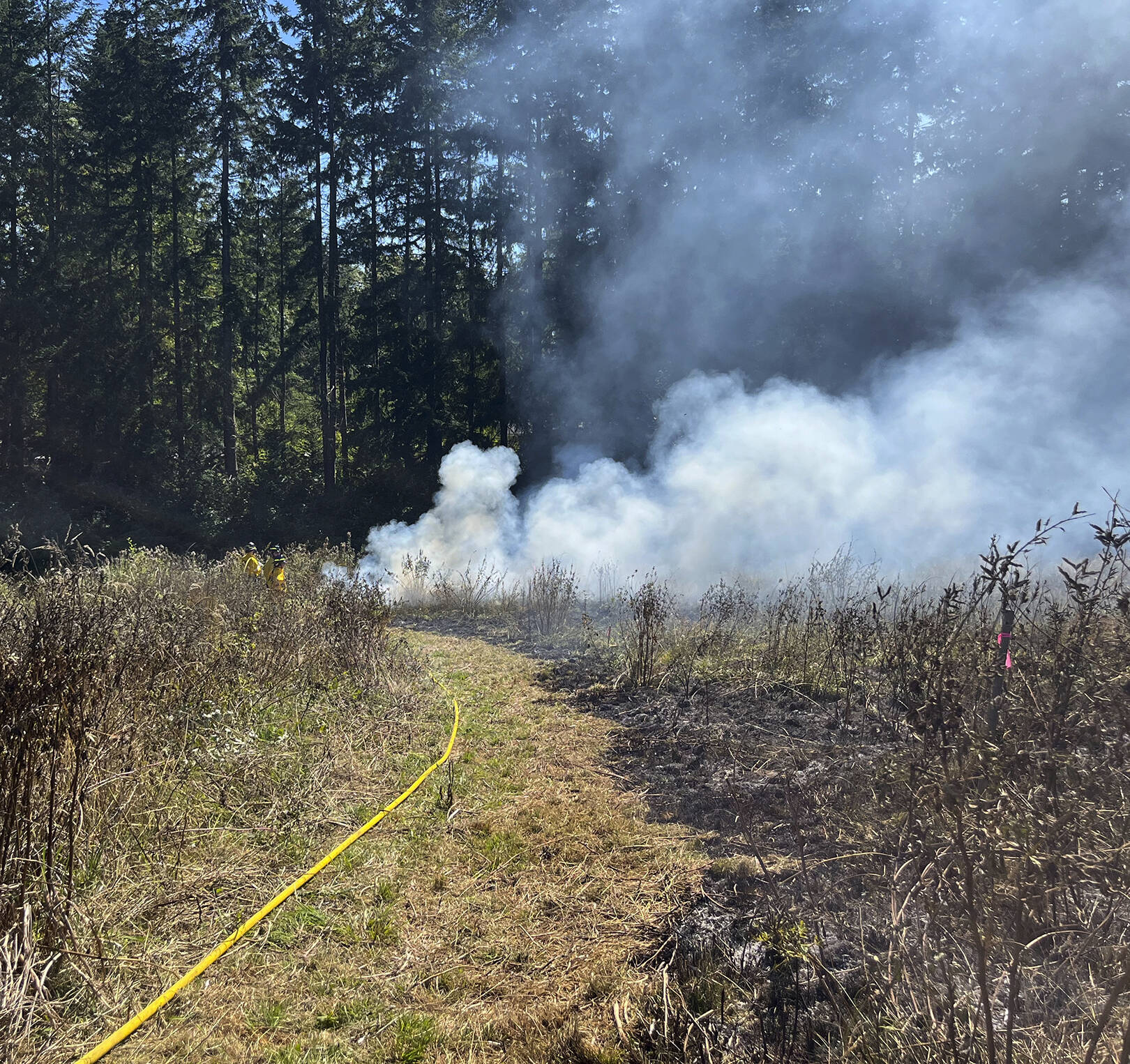Bloedel Reserve conducted the first controlled burn on Bainbridge Island since colonization Sept. 4, igniting a new era in land managment and disaster preparedness for open spaces.
Conditions were perfect for a fire: clear, windless and hot, with the dry grass of late summer standing tall and brittle. All that was needed was a spark — exactly what Kaslin Daniels, director of horticulture and design at Bloedel, was hoping for.
The BI Fire Department, BI Land Trust, BI Metro Parks and Recreation District and Bainbridge Prepares joined Daniels and several other Bloedel employees to assist with the burn and explore how the process may be of use.
“Fire as a landscape management tool has been used for centuries. It is one of the reasons that prairies exist in the US,” Daniels said. “The process will help lock nutrients in the soil, especially carbon, and help restore the native plants in the burn zone.”
Controlled burns for ecological purposes occupy a gray area on BI: the fire department restricts their use to dispose of yard vegetation or garbage, and while the fire marshal issues permits for agricultural fires they are exclusively for commercial farming operations.
When Bloedel managers first attempted to have a controlled burn in 2021, they had to acquire a permit and wait until a countywide burn ban lifted. But by the time that ended the grounds were too wet for a fire. This year, Bloedel was able to acquire permission from the fire marshal to try again.
The burn took place in the Buxton Pollinator Meadow, an area of the Bloedel set aside for native and perennial flowering plants. Fire tearing through a field of dry grass a few feet from a group of 25 people is a terrifying thought — but in practice, with the proper precautions, it’s surprisingly calm.
For example, the fire doesn’t smell like much, because most of the billowing vapor is steam. The flames only lick about 6 inches off the ground, and they move slowly, leaving a patchwork of green fire-resilient native plants and black-scorched grasses. The whole process only takes about 20 minutes.
“We’re taught the basics of wildfire management in class, but it’s not often we get a chance to practice so close to home,” BI fire chief Jared Morevac said.
Two of the firefighters had been recently deployed to Yakima. One shared a video from the front lines: a roaring wall of fire and ash consuming mature conifers over 40 feet tall. Treating forested areas on BI is “just a dream at this point,” Morevac said. For now, it’s cold burns in open areas only.
“Today, the burn is just herbaceous material,” Daniels said. “Burning will keep out woody material, like shrubs and trees.”
Bloedel gardeners will distribute native bunchgrass and wildflower seeds into the burned patches, hoping the fire-resilient species will outcompete the invasive European grass, introduced nationwide by early settlers for livestock.
The open space was once a 5-acre sheep pasture, and Bloedel managers have been reintroducing new plants to replace the monoculture. Not every species they plant is native to Washington — about 70% are U.S. native plants — but that’s intentional, Daniels said.
“Our primary focus is habitat creation — we want to increase biodiversity and create food sources for all kinds of pollinators, like birds, butterflies, bees, bats, flies, ants, beetles and moths. It’s a balance between ecology and aesthetic value,” she said. “This is very much a living lab and in a way, a demonstration garden.”
Renovation is not simply pulling up the grass, tilling soil and dropping seeds — wild plants, particularly meadow-dwellers, depend on an intact mycorrhizal network in the soil to thrive. The horizontal roots of plants are connected to each other through an underground web made of threadlike fungus. Plants can use the fungi highway to send nutrients and water to one another, and the fungus is able to absorb carbon through the plants. When soil is tilled, that destroys the network, which makes it harder for new plants to grow.
That’s why Bloedel is exploring multiple techniques to treat the meadow, in various corners of the pasture: fire, for one, but also soil solarization, manual treatments like weeding, and grazing chickens. “Landscape evolution takes a long time. We can’t say one thing will work definitively, year over year. It’s a long game,” Daniels said.
Andrew Fraser, stewardship manager of the BI Land Trust, watched the burn and pointed out lupins that had blackened but not burned, scotch broom that had stood fast against the flames and ground cover that had been skipped over. “Our native prairie requires fire—it needs that chemical change. If we could return that functionality to the land on Bainbridge, it’s worthwhile to do it,” Fraser said.
The trust is keenly interested in the efficacy of controlled burns on BI, he said. In past years, the trust has stuck to a more hands-off management style; non-native species like Himalayan blackberry and English ivy were able to grow unimpeded. Recently, stewardship has begun to take precedence.
“We’ve pivoted to new approaches, like on Manzanita Ridge, but a lot of [our land] has neighbors,” Fraser said. “So there’s an ecological angle, but there’s also an educational element of the urban-wild interface. Bloedel shows it can be done in a serious way.”



